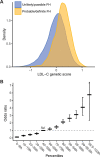Large-Scale Screening for Monogenic and Clinically Defined Familial Hypercholesterolemia in Iceland
- PMID: 34407635
- PMCID: PMC8454500
- DOI: 10.1161/ATVBAHA.120.315904
Large-Scale Screening for Monogenic and Clinically Defined Familial Hypercholesterolemia in Iceland
Abstract
Objective: Familial hypercholesterolemia (FH) is traditionally defined as a monogenic disease characterized by severely elevated LDL-C (low-density lipoprotein cholesterol) levels. In practice, FH is commonly a clinical diagnosis without confirmation of a causative mutation. In this study, we sought to characterize and compare monogenic and clinically defined FH in a large sample of Icelanders. Approach and Results: We whole-genome sequenced 49 962 Icelanders and imputed the identified variants into an overall sample of 166 281 chip-genotyped Icelanders. We identified 20 FH mutations in LDLR, APOB, and PCSK9 with combined prevalence of 1 in 836. Monogenic FH was associated with severely elevated LDL-C levels and increased risk of premature coronary disease, aortic valve stenosis, and high burden of coronary atherosclerosis. We used a modified version of the Dutch Lipid Clinic Network criteria to screen for the clinical FH phenotype among living adult participants (N=79 058). Clinical FH was found in 2.2% of participants, of whom only 5.2% had monogenic FH. Mutation-negative clinical FH has a strong polygenic basis. Both individuals with monogenic FH and individuals with mutation-negative clinical FH were markedly undertreated with cholesterol-lowering medications and only a minority attained an LDL-C target of <2.6 mmol/L (<100 mg/dL; 11.0% and 24.9%, respectively) or <1.8 mmol/L (<70 mg/dL; 0.0% and 5.2%, respectively), as recommended for primary prevention by European Society of Cardiology/European Atherosclerosis Society cholesterol guidelines. Conclusions: Clinically defined FH is a relatively common phenotype that is explained by monogenic FH in only a minority of cases. Both monogenic and clinical FH confer high cardiovascular risk but are markedly undertreated.
Keywords: genetic screening; genetics; hypercholesterolemia; lipids; mutation.
Figures




Comment in
-
What Is the Prevalence of Familial Hypercholesterolemia?Arterioscler Thromb Vasc Biol. 2021 Oct;41(10):2629-2631. doi: 10.1161/ATVBAHA.121.316862. Epub 2021 Aug 26. Arterioscler Thromb Vasc Biol. 2021. PMID: 34433299 No abstract available.
-
Response by Björnsson et al to Letter Regarding Article, "Large-Scale Screening for Monogenic and Clinically Defined Familial Hypercholesterolemia in Iceland".Arterioscler Thromb Vasc Biol. 2022 Jan;42(1):e46-e47. doi: 10.1161/ATVBAHA.121.317201. Epub 2021 Dec 22. Arterioscler Thromb Vasc Biol. 2022. PMID: 34936471 No abstract available.
-
Letter by Tromp et al Regarding Article, "Large-Scale Screening for Monogenic and Clinically Defined Familial Hypercholesterolemia in Iceland".Arterioscler Thromb Vasc Biol. 2022 Jan;42(1):e44-e45. doi: 10.1161/ATVBAHA.121.317188. Epub 2021 Dec 22. Arterioscler Thromb Vasc Biol. 2022. PMID: 34936472 No abstract available.
References
-
- Defesche JC, Gidding SS, Harada-Shiba M, Hegele RA, Santos RD, Wierzbicki AS. Familial hypercholesterolaemia. Nat Rev Dis Primers. 2017;3:17093. doi: 10.1038/nrdp.2017.93 - PubMed
-
- Nordestgaard BG, Chapman MJ, Humphries SE, Ginsberg HN, Masana L, Descamps OS, Wiklund O, Hegele RA, Raal FJ, Defesche JC, et al. ; European Atherosclerosis Society Consensus Panel. Familial hypercholesterolaemia is underdiagnosed and undertreated in the general population: guidance for clinicians to prevent coronary heart disease: consensus statement of the European Atherosclerosis Society. Eur Heart J. 2013;34:3478–390a. doi: 10.1093/eurheartj/eht273 - PMC - PubMed
-
- Bruikman CS, Hovingh GK, Kastelein JJP. Molecular basis of familial hypercholesterolemia. Curr Opin Cardiol. 2017;32:262–266. doi: 10.1097/HCO.0000000000000385 - PubMed
-
- Goldstein JL, Brown MS. The LDL receptor locus and the genetics of familial hypercholesterolemia. Annu Rev Genet. 1979;13:259–289. doi: 10.1146/annurev.ge.13.120179.001355 - PubMed
-
- Abul-Husn NS, Manickam K, Jones LK, Wright EA, Hartzel DN, Gonzaga-Jauregui C, O’Dushlaine C, Leader JB, Lester Kirchner H, Lindbuchler DM, et al. . Genetic identification of familial hypercholesterolemia within a single U.S. health care system. Science. 2016;354:aaf7000. doi: 10.1126/science.aaf7000 - PubMed
Publication types
MeSH terms
Substances
LinkOut - more resources
Full Text Sources
Miscellaneous

